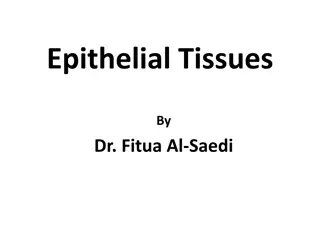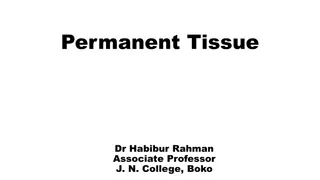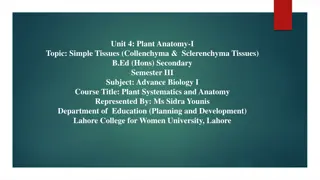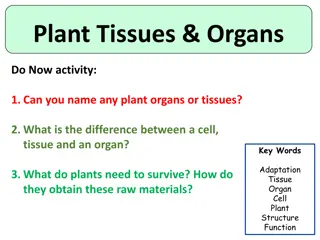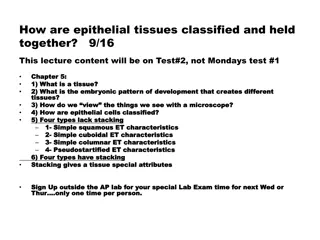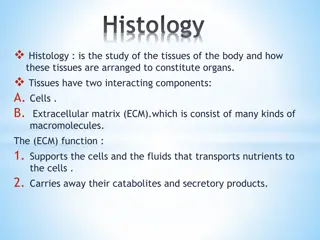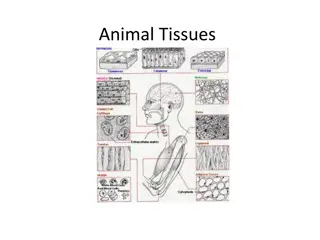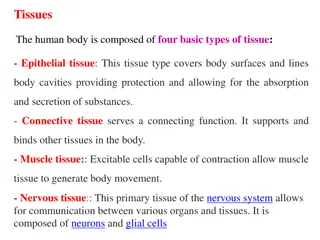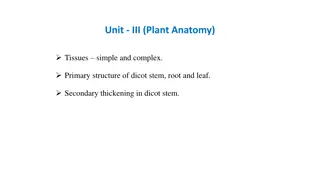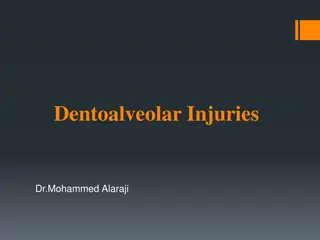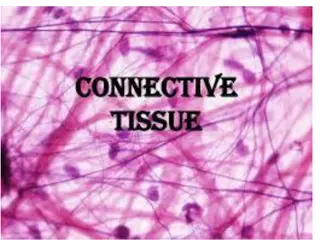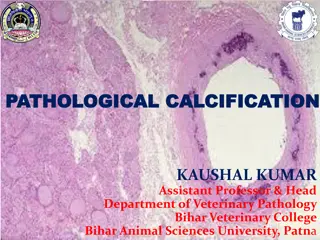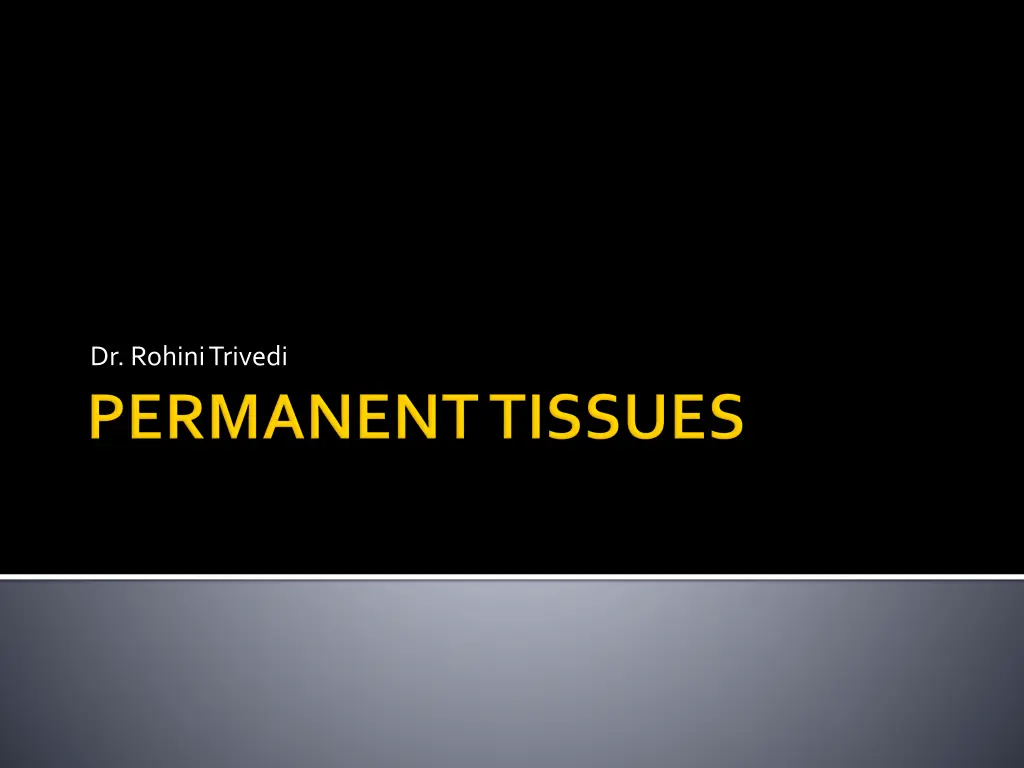
Understanding Permanent Tissues in Plants: Types and Functions
Explore the formation and characteristics of permanent tissues in plants after division and differentiation. Learn about the three types of permanent tissues - Simple tissues, Complex tissues, and Special tissues, their composition, structure, and functions. Discover how these tissues play a crucial role in plant growth and development.
Download Presentation

Please find below an Image/Link to download the presentation.
The content on the website is provided AS IS for your information and personal use only. It may not be sold, licensed, or shared on other websites without obtaining consent from the author. If you encounter any issues during the download, it is possible that the publisher has removed the file from their server.
You are allowed to download the files provided on this website for personal or commercial use, subject to the condition that they are used lawfully. All files are the property of their respective owners.
The content on the website is provided AS IS for your information and personal use only. It may not be sold, licensed, or shared on other websites without obtaining consent from the author.
E N D
Presentation Transcript
Permanent tissues are formed after division and differentiation. permanent tissues the ability of division is lost temporarily or permanently . They differentiate and takes a definite shape and perform a definite and specific job or function. In the
They are of threetypes Simple tissues Complex tissues Specialtissues
These tissues are composed of only one type of cells which are similar in their structure and function. That is all the cells are homogenous. Simple tissues are again of three types Parenchyma Collenchyma Sclerenchyma
Cell wall are thin composed of cellulose and calcium pectate .Cells are living with a clearand welldefinednucleus. Intercellular space is found between cells. Cellsarewith vacuole. The cell shape can be round, oval, rectangular,cylindricalor stellate
Foundinallthesoft tissues inplants. They are also found in complex tissues like xylemandphloem. They are simple primary cells. Most of the plant part is made up of this type of cells. That s why they are called ground tissues. Rest of all the cells and tissues develop from thisbasictypeofcells
They meristematic cells. The parenchymatous cells found in primary xylem and phloem tissues develops form procambial cells . The parenchymatous cells found in the secondary xylem and phloem is formed from cambium and corkcambium develop from the primary
They are mostly isodiametric but in some plants they can be long and of differentshapes. They are set close to each other without much intercellular parenchyma tissue of endosperm but the pulp of fruits have large intercellular spacesbetweenthe parenchyma cells. space in the
Usually the cell wall is thin composed of cellulose, pectin Plasmodesmata is parenchyma cells of secondary xylem arethickwalled with lignin. The cell content differs according to theirfunction but nucleusinfound inall. and hemicellulose. present . The
Chlorenchyma when chloroplast is present . These photosynthesis. Aerenchyma large intercellular space is found . The space is filled with gas. This makes the tissue buoyant . These tissuearefound in aquatic plants. tissues perform
Idioblasts-these are special type of parenchyma in which tannin , oil, calcium oxalate crystals like raphides are stored. Prosenchyma parenchymatous cell iso diametric to elongated with tapered ends slightly thick walled found in the pericycleof dicots.
Stellate parenchyma star shaped with large intercellular spaces . Found in the leaf base of bananaandcertainaquaticplants. Functions store starch ,protein, oil like in potato and castor, performs photosynthesis, provides buoyancy, stores water for example in Opuntia and Euphorbia , divides and provides cells for secondary growth and for healing the injured parts. chlorenchymatous
Develops thickened at corners diagnostic feature of this tissue they are longer than parenchyma cells the cell wall contains cellulose , hemicellulose and pectin but hydrophilic nature of pectin causes the cellwall to besoft and moist. from parenchyma and which is a not lignin. The
The cell wall gets thickened along with the elongation. Found in the soft organs like branches, stems leaves, leaf bases giving flexibility along with strength. They are the reason why plants can bend in response to strong winds without breaking .
It is found in the primary structure of usually a dicot plant and very rarely or absent in monocot plants, not found in underground parts. In dicot stem it is found epidermis as layer forming hypodermis.. beneath or the patches
Different thickening by the pectin and hemicellulose Angular collenchyma-when thickening is found at the corners example in Datura and Lycopersicon (tomato). the
Lacunar or tubular collenchyma-clear and distinct intercellular space is present and the thickening is present on the cell wall which is near to or surrounding the intercellular space example in Salvia and Malva.
Lamellar thickening walls rather than the radial wall example in stemof Raphanus or plate collenchyma- the tangential along
Gives elastic strength or tensile strength, avoiding breakage of branches in strong winds. Development of chloroplast in the different organsleadsto makingoffood As they are living they can divide according to need and convert into meristematic cells and fillstheinjury andforms cambium.
The cells are long, tapering at the ends, the cell wall are thick, lignified and are dead when mature. Simple pits are found in these tissues. deposition of lignin is found only inthesetissues. Thickening by
The thick wall leads to attainment of permanent shape by the cells. The space occupied by the cytoplasm is reduced gradually due to deposition of layers of lignin. As lignin is not permeable to water the less water content of the cell leads to death of thecells.
Two types of sclerenchymaare found normally Sclerenchymafibres Stone cells or sclerids
The cells are long, thin and tapering on both ends. Sometimes the cell wall gets very thick and the lumen gets very thin or completely blocked. The cell wall has small simple pits. They are found in the cortex, pericycle, xylem and phloem . In monocots they form a boundary up or down the vascular bundle and is called the bundlesheathcells.
On the basis of presence of the fibres in the plant axis they are divided into two groups- Wood fibres, xylary fibres- they arise from the same meristematic cells from which the rest of other xylem cells arises. Found in tracheids of secondary xylem. The secondary wall is lignified. They are extremely thin and long the ends are thin andpointed
Found in many plants as circular strips or patches. They are originated from phloem they are also calledpericyclicor perivascularfibres. The fibres are long, soft and the heads or ends are tapered or pointed. For this reason they get entangled with each other. thought to be
For this reason the fibers of the whole strip cam together. The mechanical strength so conferred makes them important for making ropes, mats. In plants also they provide strength so that the plants can take pressure. be isolated mechanical
The length of the fibres is 20mm. Some time the fibres are as long as 200mm. In dicots they are found in Crotolaria juncea, Hibiscus cannabis and Corchorus capsularis (jute). strength the fibres have give them economic value they are used for making ropes, mats,bags The mechanical
In monocots the useful fibres are obtained from the leaves. The lignified walls are comparatively more thick. They are smaller, more rough and smaller in comparison. They are called hard fibres. The fibres of Musa textilis, Agave areexample.
They are also called stone cells and they are found in most of the plants. They are more broader than their length, with thick wall and narrow lumen. They are isodiametric but someareelongated also.
Stone cells are present in hard parts like endocarp of coconut, hard seed coats and also in some fruit pulp. They are common in cortex and pith of gymnosperms. Function of scleridsismechanical.
Brachysclerids- (small , oval or rounded ) foundincortex, pithandphloemofstem. Macrosclerids ( large rod shaped) found in hardseedcoatof leguminosaefamily. Osteosclerids bone shaped found in the hypodermaltissue ofmanyseedsandfruits. Asterosclerids star shaped found in inter cellularspaceofleavesofsomehydrophytes.


